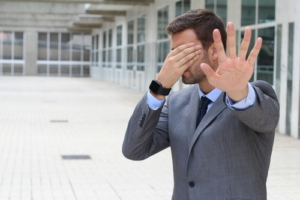Resistance to change is embedded in the way most people talk about and think about change. Every day I hear someone talking about resistance to change. It could be the leader who wants to move the company in a new direction and asks how to manage employee resistance. Or it’s in general conversation when someone says, “we all resist change.”
The language of resistance can hurt your organizational change efforts. That’s because the language we use to describe any situation or event influences our perception, beliefs, and the actions we will or won’t take. And those actions directly impact the outcome of your change initiative.
That’s why I recommend changing the way we talk about change. Let’s stop talking about resistance to change, adopt a readiness mindset and start talking about building readiness.
How Language Reinforces Resistance to Change
We use language to organize our thinking, which causes us to pay attention or remember things differently[1]. Think about that for a moment.
What happens when you call a group or person resistant to a change you want to make in your organization? When I ask leaders that question, some talk about feeling defensive and irritated. While other express frustration, disappointment, discouragement, and other similar emotions.
Fueled with these negative emotions, you introduce the change expecting people to resist. You hear and interpret any push back, questions, or less than positive response as evidence of resistance. Thus, reinforcing and confirming your belief and creating a toxic cycle.
 You end up focusing on managing the resistance instead of preparing people and ensuring people feel supported through the change process. The result is a reactive instead of a proactive approach to organizational change.
You end up focusing on managing the resistance instead of preparing people and ensuring people feel supported through the change process. The result is a reactive instead of a proactive approach to organizational change.
Adopting a readiness mindset(TM) and using the language of readiness breaks this cycle of resistance to change.
Using a readiness mindset you can describe what is happening beyond just labeling the behaviour as resistance to change. With a broader way of describing what’s happening, you can reflect and respond to the normal human responses to change without creating a defensive reaction in yourself or the change recipients.
I experienced this while working with a group of change leaders to facilitate the adoption of new technology within a large organization. After a meeting with a group of employees, one of the change leaders commented the employees were resistant to the change. A closer examination of the dialogue and the employees’ reactions during the meeting revealed a very different picture. The employees were not resistant to the change: they expressed clear support for the new technology. They were concerned about their capabilities to do their work with the technology and the implementation process.
Exploring the response from a readiness perspective allowed us to identify the specific activities needed to enable adoption. As a result, the group had one of the highest and fastest rates of adoption.
Towards a New Vocabulary: Readiness for Change
Language is so powerful that a single or couple of words can change our perception and action. For example, we have one perception and emotion when we hear; “he is resistant to change” and a different perception when we hear “he is unprepared for the changes.”
That’s why in our work to help leaders create a change-ready organization; I ask leaders to eliminate resistance to change from their vocabulary. Instead, I coach them on the readiness mindset. Then I show them how to use a language grounded in readiness to change the conversations and perceptions about change.
Language alone will not build readiness for change, but it is a starting point. Adopting a readiness mindset and vocabulary grounded in readiness instead of resistance to change will allow you to create a new conversation about the changes needed in your organization. It releases you from the current resistant or not resistant dichotomy.
A language grounded in readiness encourages different questions, expands your understanding of the change process and reduces the stress of organizational change. Overlooking readiness in favour of resistance or viewing resistance as one facet of readiness, you can neglect important and necessary interventions needed to support and enable change.
Like any change, adopting a new vocabulary takes time, a willingness to shift your thinking, and a commitment to act. Here are three things you can do to adopt the language of readiness:
- Recognize how often you identify a person or a group as resistant to change and how it influences your communication and approach.
- When planning for an organizational change, instead of asking, “How will we manage the resistance? Ask; “What will be required to get our employees ready for this change?”
- Make the time to learn and integrate the human dynamics of change into your leadership practices and transform into a change-ready organization.
When you change your language, you change your thinking which changes your actions.
References
[1] Proffitt, D., & Baer, D. (2020). Perception: How our Bodies Shape Our Mind



